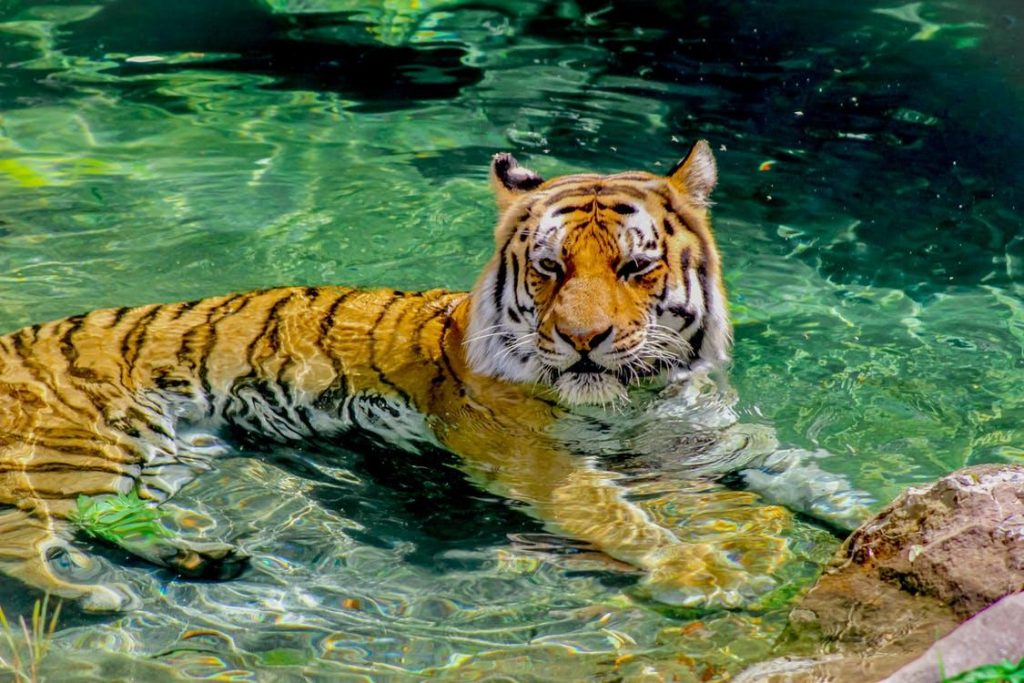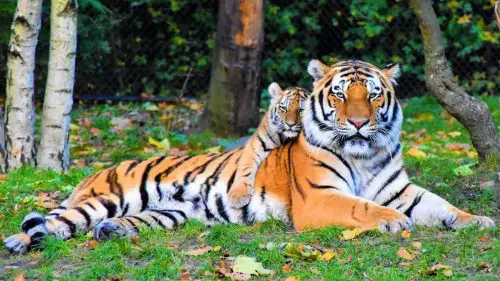Tigers are members of the terrestrial animal group known as Panthera, which also includes other big cats. Because they are the biggest species in their family, the Felidae, as well as having a one-of-a-kind black and orange striped pattern on a dark orange coat, they are fairly simple to detect. In addition, they have a unique striped pattern that runs from their head to their tail. There are five distinct species of extremely large cats that belong to the genus “Panthera,” but the tiger (Panthera tigris) is the largest of the group.

Do Tigers Hibernate?
The easy answer is No. The fact that tigers are native to warm climes and tropical environments preclude the possibility of their engaging in the behavior known as hibernation.
Because of this tendency, hibernating mammals are the only ones that are able to make it through the harsh winter months. Before going into hibernation, they bring their body temperature down, which allows them to save a substantial quantity of energy. Animals that hibernate slow down their metabolic rate in addition to the rates at which their hearts beat and their breaths are taken in order to maximize the amount of energy that they may save while there is a shortage of food.
Does The Siberian Tiger Hibernate?
There is no such thing as migration or hibernation for Siberian tigers; they do not do any of those things. Instead, they are able to survive the winter by eating other animals that, like them, neither hibernate nor migrate during the colder months.

Can Tigers Survive In Cold Weather?
Yes, there is a subspecies of the tiger known as the Amur tiger, also known as the Siberian tiger, which lives in the easternmost part of Russia. These tigers have developed a specialized adaption that allows them to live in colder environments. The way that they eat and the fur on their skin both contribute to their ability to survive in cold environments.

What are Five Interesting Facts About Tigers?
- The true king of the jungle
- Fake eyes
- Hunt alone at night
- Fast runners
- Only cats who love water
1. True king of the jungle
Although we have all previously been told that lions are the kings of the forest, this statement is not accurate. Tigers are the true actual apex predators of the jungle. They dominate other cats in terms of size, power, and overall body mass in every conceivable aspect (including lions). In addition to this, the jungle, and more especially the jungles of Asia, serve as their natural environment. It is possible for a single tiger to grow to a maximum length of 2.8 meters and a maximum weight of 300 kg in its lifetime (as long as a small car).
2. Fake eyes
They have something that may be mistaken for eyeballs but is actually referred to as an ocelli. White patches of fur on the side of each ear provide the impression that the animal is dangerous to other animals, causing them to flee in terror. The tiger always gives the appearance that it is watching those humans, even when its head is turned in the opposite direction or while it is resting.

3. Tiger hunt alone at night
Tigers are members of the category of animals known as carnivores. They are solitary hunters that only come out at night. If you have the agility of a tiger and the strength of a bear, you won’t need any help from your hunting friends when you head out on the hunt. Nighttime is the best time of day for these felines to hunt their lonely prey. Consumption options will include buffalo, wild pigs, and deer, among other large species. It is impossible for a tiger to survive on nibbles alone. They are able to consume around 30 kg of meat in a single sitting if they so want.

4. Fast runner
Even though they are large and cumbersome, they are not sluggish in the least! These cats are capable of reaching speeds of up to 65 kilometers per hour while running at full tilt and can go up to 30 kilometers in a single night when they are hungry. Because of this, they must inhabit enormous territories that are densely forested and offer plenty of both water to drink and prey for them to consume.
- Only cats who love water
The tigers are fantastic swimmers and they like being in the water. They can swim over quite great distances and even hunt while they are in the water. The mother tigers will teach their cubs how to swim when they are old enough. Therefore, even an animal that is completely submerged in water is not safe from an assault by a tiger since they are so powerful.

Is there a tiger that lives in the snow?
There is a species known as the Amur Tiger that inhabits snowy regions where the average temperature is well below freezing and there is typically a significant amount of snow cover. They have a high level of cold tolerance built into their physiology as a result of this adaptation. In addition to their enormous size, tigers have a number of unique “built-in” adaptations that enable them to live in colder regions.
They have a covering of fatty layers that helps and protects them from harsh weather, and they can be found on both their sides and their bellies. This layer helps and protects them from being eaten by predators. In addition to this, their fur is long and thick, both of which contribute to their success.

What are tigers afraid of?
Tigers have a pathological fear of flames and won’t even attempt to run through burning hoops. It’s possible that the tigers at a circus who are made to run through a flaming hoop are more scared of the trainer’s physical punishment than they are of the fire itself.
Do tigers like people?
Although people are relatively easy food, tigers normally avoid them. They are usually afraid of humans and prefer to stick to animals. As a result, most human victims were attacked by hungry or elderly tigers.
Which animals eat tigers?
The human race is this animal’s natural predator. They may also be threatened by larger animals such as elephants and bears. There are much more animals that prey on tiger cubs than there are on adults. There are several different animals that prey on cubs, including as hyenas, crocodiles, and snakes.
Why don’t tigers exist in Africa?
Many people who study wildlife think that in the distant past, tigers lived over much of Asia and that different subspecies of tigers spontaneously moved and dispersed across the continent over the course of time. However, it is likely that glacial shifts and the formation of new geographic borders throughout the Pleistocene rendered it impossible for tigers to migrate back to Africa.
How many tigers will there be in the world in 2021?
There are still an estimated 3,900 tigers living in the wild, but we need to put in far more effort to safeguard this species if we want to ensure that it has a future there. There are still pockets of the world where tigers are experiencing population declines, notably a significant portion of Southeast Asia.
What do tigers do in winter?
Tigers, which live in warmer climes and so need to cool down, make use of the camouflage provided by their stripes by lounging in the shadows cast by streams and ponds.
Where do tigers live? Is it warm or cold?
The tiger has the ability to survive in a wide range of climates, from the frigid taiga of Siberia, where nighttime temperatures can drop to 40 °C (40 °F), to the hot and humid mangrove swamps of the Sundarbans, where the average annual temperature is above 40 °C (104 °F).
Which of the various species of tigers is the most powerful?
The Bengal Tiger is the most powerful, biggest, and heaviest of all the species of tigers, whereas the Siberian Tiger is capable of killing Russian brown bears in addition to any other big cat.
Do Any Guinea Pigs Live in Cold Places and Hibernate?
Guinea pig hibernation explainer: Guinea pigs are not built for the cold. Unlike many animals that hibernate, guinea pigs cannot enter a true hibernation state. They are highly sensitive to cold temperatures and lack the necessary adaptations to survive in cold places. It is crucial to provide them with a warm, cozy environment to keep them healthy and comfortable throughout the year.
What is the lifespan of tigers?
In the wild, a tiger may expect to live for around 11 years on average. Their lifetime in captivity ranges from roughly 20 to 26 years on average. When tigers are kept in private ownership or in zoos, their lifespans are significantly lengthened, which is something that should come as no surprise. This is due to the fact that they are no longer need to worry about looking for food or being subjected to arduous weather conditions.











